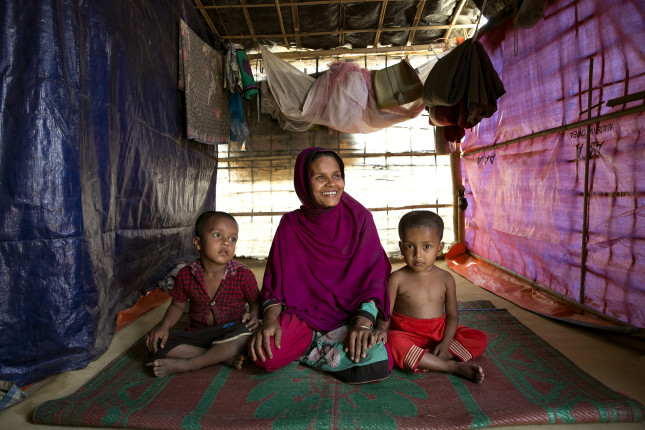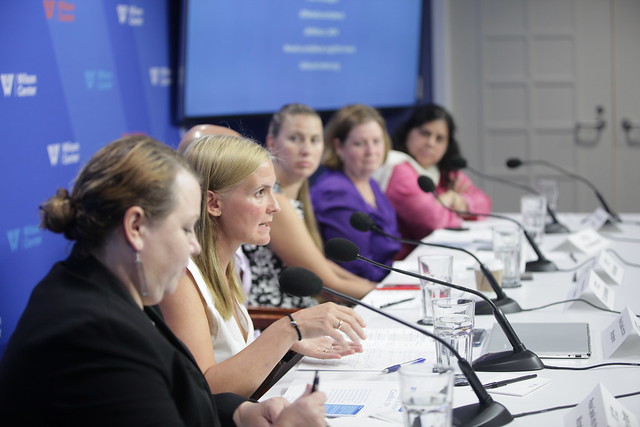-
Mothers on the Front Lines: Armed Conflict, Aid Distribution, and Maternal and Child Health
September 12, 2018 By Elizabeth Wang
While most people killed in wars are male, several studies have found that “mortality among women in some high-intensity conflicts was as severe as male mortality,” said Henrik Urdal, the Director of the Peace Research Institute Oslo (PRIO), at a recent Wilson Center event on the links between maternal and child health, aid, and armed conflict. “Maternal health is a very natural place to start” when researching excess mortality and indirect deaths among women impacted by war, said Urdal.
Conflict Increases Risk of Maternal, Child Mortality
“The damages really extend far beyond the direct combatants in conflict,” said Dr. Eran Bendavid, an Associate Professor of Medicine at Stanford University. Most conflict research focuses on direct combatant and civilian deaths caused by organized violence, so there are less data on its indirect health effects on women and children.
Violent conflicts “increase the risk of the child not making it to his or her first birthday,” said Bendavid. In a study of 35 African countries published in The Lancet, Bendavid and his coauthors found that a child born within 50 km of armed conflict had a 7.7 percent higher risk of dying before the age of one year than another born in the same region during periods without conflict.
“We need to get a better understanding of why organized violence reduces the use of maternal health services,” said Gudrun Østby, a Senior Researcher at PRIO. Local-level evidence from sub-Saharan Africa shows that proximity to recent organized violence decreases the chance that a child is born at a medical facility by approximately one percent. Although the effect seems small, one percent translates to 47,000 additional children being born outside health facilities every year due to armed conflict.
Ensuring Quality Care in Conflict and Crisis
“What does it actually mean to give birth at a health facility?” said Østby. Having access to a health facility does not guarantee that a woman will receive high quality maternal health services or have positive health outcomes. Health infrastructure and personnel are frequently targets of violence and health facilities struggle to stay functional during complex emergencies.
In Bangladesh, for example, facilities that serve Rohingya refugees face major challenges in maintaining the basic quality of reproductive and maternal health care in a humanitarian crisis in what was an already fragile state. In 2010, UNFPA launched its Midwifery Programme in Bangladesh to meet the needs of both residents and the influx of refugees. The program aims to grow a workforce of well-trained and well-supported midwives to reduce maternal and newborn mortality in these crisis settings.
The crisis in Bangladesh highlights the importance of scaling up local healthcare systems and building the capacity of local providers. “These midwives that we are deploying are fresh midwives,” said Geeta Lal, UNFPA’s Global Midwifery Programme Coordinator. “They need mentoring, they need support, they need clinical skills.”
In conflict areas, providing aid becomes challenging and dangerous for both the recipients and the providers. “The people who are working there, the midwives who are working there, they’re risking their lives every single day,” said Lal.
Local maternal and child health data are essential to guiding the efforts of frontline workers. Yet monitoring access and quality of services is quite difficult during conflict. Many conflict-affected facilities do not track maternal and newborn mortality “even at the facility level, much less having any idea of what is going on at the population level,” said Dr. Kathleen Hill of USAID’s flagship Maternal and Child Survival Program.
Without adequate health reporting, information from some of the world’s severest conflicts is overlooked. In addition, data on “interventions that increase access and have an effect on health outcomes for women—maternal health—are really, unsurprisingly, not available,” said Dr. Hill.
Aid as a Double-Edged Sword
“Aid follows success rather than creating it,” said Siri Aas Rustad, a Senior Researcher at PRIO. Although proximity to aid projects is proven to reduce infant mortality, especially among marginalized groups, aid may not always reach those that need it most as it is often allocated to areas with less mortality to start with, or areas where previous aid and infrastructure are already in place.
“Aid can be politically manipulated in the way that it is distributed,” said Rustad. PRIO researchers found that areas with politically excluded groups are 35 percent less likely to receive aid from the World Bank than other areas. Consequently, development aid may exacerbate existing inter-group disparities instead of reducing them. To minimize harm, “there needs to be a more critical assessment of where aid is distributed,” said Rustad.
Policymakers and future studies should focus on the underlying factors that drive inequitable access to healthcare for mothers and children, as well as investigate how armed conflict interacts with other causes of death among these populations.
“Understanding the causes—and the causes of those causes—is critical to understanding how we can help those families stay together and stay alive in the midst of the chaos and disruption of crisis and conflict,” said Meaghan Parker of the Wilson Center.
Event Resources:
- Eran Bendavid Presentation
- Kathleen Hill Presentation
- Geeta Lal Presentation
- Gudrun Østby Presentation
- Siri Aas Rustad Presentation
Sources: Lancet, Peace Research Institute – Oslo, United Nations Population Fund, U.S. Agency for International Development
Photo Credit: A woman sits for a photo with her children in Balukhali camp, March 6, 2018,. Photo by UN Women/Allison Joyce.
 A Publication of the Stimson Center.
A Publication of the Stimson Center.




